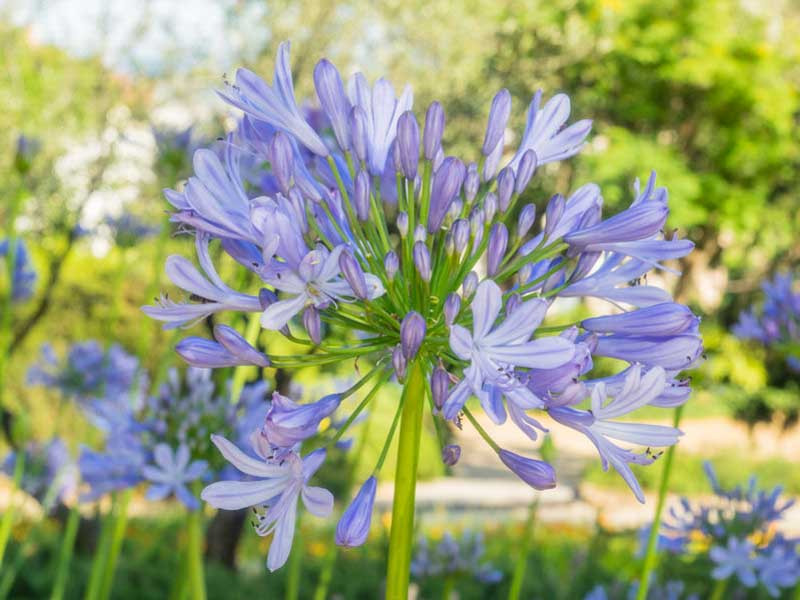Agapanthus Growing Problems: Dirt, Sunshine, and Watering
Wiki Article
Grasping the Art of Agapanthus Care: Essential Actions for Healthy And Balanced Development and Vibrant Flowers
In the realm of horticulture, the cultivation of agapanthus stands as a gratifying endeavor for those who seek to nurture these stylish flowering plants. With their striking blossoms and graceful vegetation, agapanthus has recorded the focus of gardeners worldwide. Nonetheless, achieving optimum growth and dynamic blooms needs a nuanced method that encompasses numerous important steps. From selecting the best variety to grasping pruning methods, the trip towards cultivating thriving agapanthus plants is complex and holds the crucial to opening the full possibility of these agricultural gems.
Choosing the Right Agapanthus Selection

When selecting the best Agapanthus range for your garden, consider variables such as climate viability, flower color, and development practice. In addition, think about the climate in your region to make sure the Agapanthus range you pick can flourish in your particular problems. Recognizing the development routine of various Agapanthus ranges is essential for correct placement within your garden.
Suitable Planting Problems
Taking into consideration the optimum environmental requirements is vital for effective Agapanthus cultivation. Agapanthus thrives in well-draining soil with a somewhat acidic to neutral pH degree. When planting, choose a place that receives complete sunlight to partial shade. In hotter climates, offering some afternoon shade can stop scorching of the fallen leaves. Agapanthus plants are sensitive to cool temperatures and must be secured from frost throughout winter season.To guarantee healthy and balanced development and dynamic blossoms, plant Agapanthus bulbs at a depth of about 2-4 inches and room them 8-12 inches apart. Adding organic matter, such as garden compost, to the soil can boost drainage and fertility, promoting robust root growth. Mulching around the base of the plants assists maintain moisture and subdues weed development. Routine watering is crucial, particularly during the expanding season, to keep the dirt consistently damp however not soaked.
Watering and Feeding Tips
Maintaining proper dampness levels and giving essential nutrients are essential components in the treatment routine for Agapanthus plants. When it comes to sprinkling Agapanthus, it is crucial to strike an equilibrium. These plants like regularly wet dirt but are prone to root rot if overwatered.Feeding Agapanthus is necessary for promoting healthy growth and prolific flowers. Use a well balanced fertilizer, such as a 10-10-10 formula, in the early spring as new development arises. Repeat this application every 6-8 weeks throughout the expanding season. Stay clear of excessive fertilizing, as it can cause lavish vegetation at the expenditure of blooms. Always comply with the manufacturer's guidelines description for correct dilution and application methods. this page By following these watering and fertilizing suggestions, you can guarantee your Agapanthus plants prosper and create lively, resilient blooms.
Pruning Methods for Agapanthus
Trimming Agapanthus plants at the proper times and with proper techniques is critical for keeping their health and promoting optimum development and flowering. The excellent time to trim Agapanthus remains in late wintertime or very early springtime prior to brand-new development arises. Begin by getting rid of any kind of dead or yellowing leaves near the base of the plant. Cut them as close to the ground as possible without damaging the arising shoots.Deadheading spent flowers can additionally redirect the plant's energy into generating more flowers instead than setting seeds. If you want to gather seeds for proliferation, leave some blossoms to mature and completely dry on the plant.
Keep in mind to use clean, sharp devices to make exact cuts and reduce the risk of presenting conditions. Agapanthus. Normal trimming will help keep your Agapanthus looking cool and healthy and balanced while ensuring an abundant display screen of attractive flowers
Taking Care Of Usual Parasites and Illness
After ensuring proper pruning techniques for Agapanthus, it is vital to deal with typical parasites and conditions that can influence the wellness and vitality of these plants. Agapanthus plants are typically durable however can still come down with specific problems. One common bug that influences Agapanthus is the Agapanthus gall midge. This little, orange fly lays its eggs in the foliage, leading to distorted growth and flower buds that stop working to open. To fight this parasite, prune and damage any type of affected plant parts and consider utilizing insecticidal soap.One more usual concern is fungal fallen leave place, which offers as dark sores on the leaves. To avoid fungal illness, make certain great air circulation around the plants, stay clear of above watering, and eliminate any kind of contaminated leaves immediately. Furthermore, Agapanthus plants can experience from origin rot if they are planted in badly draining pipes soil. To prevent this, plant Agapanthus in well-draining soil and prevent overwatering. By being attentive and taking punctual action versus parasites and illness, you can help your Agapanthus plants thrive and create vibrant blooms.

Verdict
In conclusion, understanding the art of agapanthus treatment entails selecting the best range, giving ideal growing problems, proper watering and feeding, ideal trimming methods, and addressing typical pests and diseases. By adhering to these important steps, you can make certain healthy and balanced growth and vibrant flowers for your agapanthus plants. Bear in mind to consistently monitor and keep your plants to advertise their total health and durability.To make certain try this web-site healthy development and vivid blossoms, plant Agapanthus light bulbs at a depth of concerning 2-4 inches and space them 8-12 inches apart. By following these watering and fertilizing ideas, you can ensure your Agapanthus plants grow and produce vibrant, durable blooms.
One usual bug that impacts Agapanthus is the Agapanthus gall midget. Additionally, Agapanthus plants can experience from origin rot if they are planted in inadequately draining pipes soil. By following these vital steps, you can ensure healthy and balanced development and lively blossoms for your agapanthus plants.
Report this wiki page